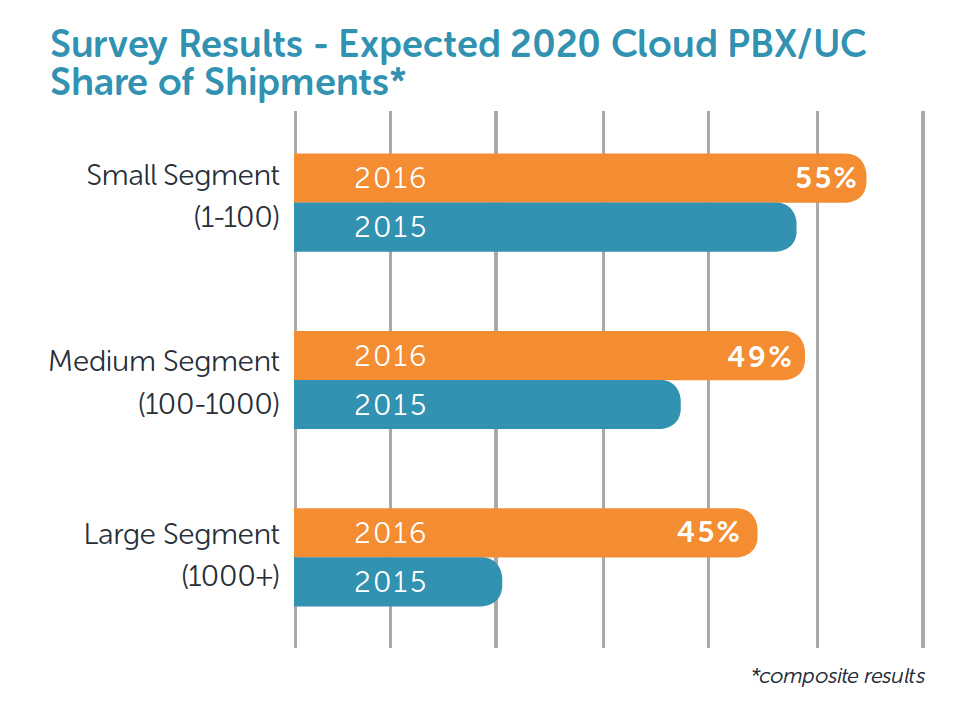GAITHERSBURG, Md., Feb. 6 (Korea Bizwire) — More than half (51%) of businesses are expected to adopt cloud Unified Communications (UCaaS/Hosted PBX) by 2020, surpassing premise-based PBX as businesses of all sizes shift to the cloud for unified communications, team collaboration and contact center services, according to the 2nd Annual BroadSoft, Inc. (NASDAQ:BSFT) survey of global telecom providers and industry leaders.
The BroadSoft 2016 survey results show that respondents expect the UCaaS/Hosted PBX share of new lines shipped to reach 51% by 2020, a 10 percentage point increase from last year’s survey results. The most significant change in optimism for cloud adoption is occurring in the large enterprise segment, where telcos expect 45% of large enterprises to adopt UCaaS/Hosted PBX by 2020 – a 25 percentage point increase from last year’s survey.
“We’ve come to a tipping point because the old PBX systems that powered communications are on their way out and are no longer being replaced or upgraded with like for like. The cloud is viable, broadband can accommodate it, the PBX vendors are no longer around and workers need more mobility,” said Taher Behbehani, chief digital and marketing officer, BroadSoft. “All of this points towards cloud adoption and digital mobile apps. We are finally reaching the stage where technology will help improve the way people work rather than dictate how they should do it.”
Key Survey Findings:
Cloud UC adoption and value accelerating across all market segments
While early stage cloud adoption is typically concentrated in the small business market, the survey finds medium and large enterprise segments rapidly catching up. Survey respondents believe that by 2020, UCaaS/Hosted PBX share will increase to:
- Small business segment (<100 employees): 55% (up seven percentage points from the 2015 survey)
- Midmarket business segment (100 – 999 employees): 49% (up 11 percentage points from the 2015 survey)
- Large enterprise segment (1,000+ employees): 45% (up 25 percentage points from the 2015 survey)
76% of survey respondents also said the cloud makes it easier for enterprises to adopt advanced UC features – contributing to higher customer value and revenue opportunities.
An infographic accompanying this release is available at
http://www.globenewswire.com/NewsRoom/AttachmentNg/b2afd0a9-ebeb-4a6f-aee8-34b26ba879fa
Mobility Integration and Experience are Key Drivers of Cloud UC
While mobility is a key priority for enterprises, the user experience of real-time unified communications on mobile delivered “Over The Top (OTT)” has not quite kept pace. For this reason, native mobile integration – which delivers an integrated mobile experience within the device’s native mobile dialer – has emerged as a key user experience driver for businesses. 89% of survey respondents believe that native mobile integration is an important requirement for mobile solutions. At the same time, results show over 90% of UC business users will require mobile integration – an opportunity for telcos in 2017 to deliver a superior native end-to-end mobile business experience.
Cloud Contact Center momentum
Along with UC, contact center solutions are also rapidly shifting to the cloud. By 2020, survey participants forecast that 43% of contact center seats will be cloud based. 84% of survey respondents also consider predictive analytics functionality to be important to end-users, suggesting businesses will increasingly seek analytics-based cloud contact center solutions that integrate with UC and team collaboration applications to enhance the customer experience.
Team Collaboration is key business user requirement
Team collaboration is emerging as a key opportunity for telecom providers, a notable trend as enterprise messaging apps gain traction in the enterprise. 78% said team collaboration is an important end user requirement in their respective markets, while 95% believe integrating team collaboration into their UCaaS offers represents a significant business opportunity.
BroadSoft conducted the survey of 130 global telecom providers and industry leader respondents in the fourth quarter of 2016 at BroadSoft Connections, the BroadSoft annual users’ conference. BroadSoft is the global unified communication software as a service (UCaaS) leader with 41% market share according to Frost & Sullivan, and recently surpassed 15 million cloud PBX/Hosted PBX lines deployed.
About BroadSoft:
BroadSoft is the technology innovator in cloud communications, collaboration, and contact center solutions for businesses and service providers across 80 countries. We are the market share leader for cloud unified communications with an open, mobile and secure platform trusted by 25 of the world’s top 30 service providers by revenue. Our BroadSoft Business application suite empowers users and teams to share ideas and work simply to achieve breakthrough performance.
For additional information, visit www.BroadSoft.com.
Investor Relations:
Chris Martin
+1 561-404-2130
cmartin@broadsoft.com
Media Contacts:
Americas
Brian Lustig, Bluetext PR for BroadSoft US
+1 301.775.6203
brian@bluetext.com
Europe
Andy Crisp / Kate Anderson, Cohesive for BroadSoft UK
+44 (0) 1291 626200
broadsoft@wearecohesive.com
APAC
Terry Alberstein, Navigate Communication
+61 (0) 458-484-921
terry@navigatecommunication.com.au
Source: BroadSoft, Inc. via GLOBE NEWSWIRE








Pingback: UCaaS Adoption Surges as Enterprises Embrace Cl...